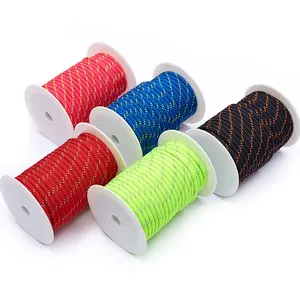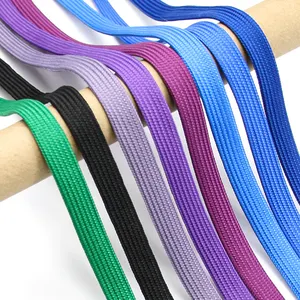(5659 products available)


































































 Ready to Ship
Ready to Ship





















































































































Flat braid ropes come in different types based on the material used to make them. Here are some of the flat braid ropes available:
Polyester Flat Braid Rope
Polyester is a popular material for making braided flat rope due to its exceptional strength and durability. It has low stretch and excellent resistance to UV rays and chemicals, making it suitable for outdoor applications such as boating, climbing, and general-purpose tying and securing tasks. Its flat braid construction provides a wide surface area for friction, which enhances grip and stability when used with knots or in conjunction with pulleys.
Nylon Flat Braid Rope
Nylon is known for its high tensile strength and elasticity, which makes it an ideal flat braid rope for applications that require shock absorption, such as marine rigging and rescue operations. The elasticity of nylon helps absorb sudden impacts, reducing the risk of rope failure under heavy loads or dynamic forces. Additionally, nylon has good resistance to abrasion and UV radiation, ensuring a long lifespan even in harsh environments.
Polypropylene Flat Braid Rope
Flat braid polypropylene rope is lightweight and floats on water, making it an excellent choice for marine applications such as mooring lines and fender lines. It is also resistant to chemicals and mildew, which makes it suitable for both indoor and outdoor use. Although polypropylene has lower tensile strength than polyester or nylon, its affordability and versatility make it a popular option for general-purpose applications.
HMPE (High Modulus Polyethylene) Flat Braid Rope
HMPE ropes, like Dyneema or Spectra, offer exceptional strength-to-weight ratios, making them ideal for applications that require lightweight yet high-strength ropes. These ropes have minimal stretch and excellent abrasion resistance, making them suitable for marine rigging, sailing, and high-performance applications. The flat braid construction of HMPE ropes provides excellent grip and stability, making them easy to handle and knot.
Kevlar Flat Braid Rope
Kevlar is renowned for its high heat resistance and tensile strength, making it suitable for applications that involve exposure to high temperatures or heavy loads. Its flat braid construction provides flexibility and ease of handling, making it suitable for use in safety harnesses, heat-resistant applications, and industrial uses where strength and heat resistance are critical.
These are some essential design elements in a braid rope.
Material
The material is the most crucial design factor for a flat braid rope. It affects strength and flexibility. Polyester fibers are popular for their strength and UV resistance. They provide excellent durability for outdoor uses. Nylon is another common choice. It offers high tensile strength and elasticity. Thus, they can absorb shocks well. This makes it suitable for climbing and anchoring. Polypropylene is lightweight and floats on water. Therefore, it is ideal for marine applications. Each material has unique properties that suit specific needs.
Width and Thickness
The width and thickness of a flat braid rope impact its load-bearing capacity. A wider rope can handle more weight. It distributes the load over a larger area. This reduces stress on each fiber. Thickness also plays a vital role. Thicker ropes usually have higher tensile strength. They can withstand greater forces without breaking. For example, a rope with a width of 2 inches and a thickness of 0.5 inches may support heavier loads than a 1-inch wide and 0.3-inch thick rope. Users must choose the right dimensions for their applications.
Braid Pattern
The braid pattern affects the rope's flexibility and strength. A symmetrical pattern provides even tension distribution. Thus, it enhances the rope's strength. An asymmetrical pattern may offer greater flexibility. This makes the rope easier to handle. For instance, a double braid construction offers high strength and low stretch. It is suitable for mooring and towing. Single braid ropes, however, are more flexible. They are better for rigging and sheaves. The choice of pattern depends on the desired properties.
Color and Coating
Color and coating serve functional and aesthetic purposes. Bright colors enhance visibility and safety. They make the rope easier to see in different conditions. Coatings like PVC or polyurethane add protection. They improve UV resistance and water repellence. This increases the rope's lifespan. For example, a rope with a bright yellow color and PVC coating will resist UV rays better than an uncoated rope. Color options range from single hues to multi-colored designs. They cater to various preferences and requirements.
End Terminations
End terminations are critical for securing and handling flat braid ropes. They affect their performance and versatility. Common methods include splicing, which interweaves the rope's strands to form a secure loop or eye. This is suitable for mooring and towing. Another method is the use of metal thimbles. They provide a rigid eye that maintains the rope's shape and prevents wear. Heat-sealing is also popular for synthetic ropes. It fuses the rope's end to prevent fraying. Each termination method has its advantages for specific applications.
Color coordination
When using braided flat ropes for clothing and accessories, color coordination is crucial. Choose colors that complement or contrast each other harmoniously. For example, a navy blue flat braided rope belt pairs well with khaki pants, creating a balanced look. Similarly, a vibrant red braid can add a pop of color to a neutral outfit, making it stand out. Consider the overall color palette of the attire and select a braid color that enhances it without clashing with other elements.
Texture and material matching
The texture and material of the flat braided rope should match the fabric of the clothing or accessory. A rope made of cotton or hemp provides a casual and organic feel, suitable for pairing with linen or cotton shirts. On the other hand, a leather braided rope offers a more sophisticated look, ideal for pairing with suede or leather jackets. This matching ensures a cohesive aesthetic and enhances the overall texture of the outfit.
Style and occasion
Consider the style and occasion when incorporating flat braided ropes into an outfit. A casual braided rope bracelet or necklace made of cotton or paracord is perfect for everyday wear, adding a laid-back and rugged charm. For formal occasions, a leather braided belt or bracelet can elevate the attire, providing a touch of elegance and sophistication. Always choose a braid style that aligns with the overall theme of the event, whether casual, formal, or outdoor.
Functionality and practicality
Beyond aesthetics, functionality plays a vital role in matching flat braided ropes to clothing and accessories. Ensure the rope is practical for its intended use. For example, a paracord bracelet serves as a survival tool in addition to being a fashion accessory, making it useful for outdoor activities. Similarly, a braided belt should be adjustable and durable, ensuring it serves its purpose while contributing to the outfit's style. Always prioritize functionality without compromising on style to create a practical and fashionable ensemble.
Q1: What are the primary applications of flat braid ropes?
A1: Flat braid ropes are versatile and are used in various applications, including maritime uses for rigging and docking, in automotive applications for securing loads and as seatbelt webbing, in sports for climbing and canyoneering, and in general utility applications for lifting, towing, and securing due to their strength and low stretch properties.
Q2: How does a flat braid rope compare to a round braid rope in terms of performance?
A2: Flat braid ropes offer different performance characteristics compared to round braid ropes. While flat braid ropes provide a stable, non-twisting construction that lies flat and is easy to handle, round braid ropes are more versatile in knot tying and can better distribute loads due to their rounded shape. Each type of rope has its advantages depending on the specific application and requirements.
Q3: Can flat braid ropes be used for lifting and rigging applications?
A3: Yes, flat braid ropes can be used for lifting and rigging applications, especially those designed for high tensile strength and low stretch. However, it's essential to ensure that the flat braid rope is rated for the specific load and application to maintain safety and effectiveness.
Q4: Are flat braid ropes suitable for outdoor and marine environments?
A4: Many flat braid ropes are constructed from synthetic fibers like polyester or nylon, which offer good resistance to water, UV radiation, and abrasion. This makes them suitable for outdoor and marine applications. However, the specific material and treatment of the rope should be considered to ensure it meets the environmental conditions of its intended use.
Q5: How should flat braid ropes be maintained to ensure longevity?
A5: To maintain flat braid ropes, it is essential to inspect them regularly for signs of wear, fraying, or damage. Ropes should be cleaned according to the manufacturer's recommendations, usually involving rinsing with fresh water and mild soap for synthetic fibers. Proper storage away from direct sunlight and moisture can also help prolong the life of flat braid ropes.